General Electric SSM-A-16 Hermes A-3B
(and other Hermes variants)
Project Hermes was officially begun by the U.S. Army in November 1944, when General Electric was awarded a contract for research, development and engineering work leading to the design of a family of test vehciles and operational guided missiles. The Hermes program also covered the U.S. Army's V-2 program (launching captured German V-2(A-4) missiles as research and test vehicles) and the RTV-G-4 Bumper project (using the V-2 and the RTV-G-1 WAC Corporal to create a two-stage research rocket).
The following Hermes sub-projects were planned by General Electric and the U.S. Army:
- Hermes A-1: Liquid-fueled rocket-powered surface-to-air missile based on German technology
- Hermes A-2: Wingless surface-to-surface variant of the Hermes A-1 (later changed to solid-fueled rocket program)
- Hermes A-3: New liquid-fueled rocket-powered surface-to-surface missile
- Hermes B: Ramjet-powered missile program (later split into Hermes B-1 and Hermes B-2, and spawning the Hermes II)
- Hermes C: Low-priority studies for long-range surface-to-surface missiles
Although the various efforts of course ran partially in parallel, each of the five basic Hermes missile projects will be discussed separately below. For an overview of the numerical designations, which were allocated to the various Hermes missiles between 1948 and 1953, refer to the table at the end of this article.
Hermes A-1
After several configurations for the Hermes A-1 surface-to-air missile had been studied, it was decided in 1946 to base the missile on the war-time German Wasserfall SAM. However, after the SAM-N-7/MIM-3 Nike project had been started in the same year, the Hermes A-1 was redefined as a pure test vehicle for guidance and control systems. During 1947 and 1948, component flight testing took place on V-2s, but problems with the rocket engine delayed the launch of the first Hermes A-1 (designated CTV-G-5 in early 1948) until 1950. After two failures in May and September 1950, the first fully successful flight occurred on 2 February 1951, followed by two more tests in March and April that year. This concluded the flight test program of the CTV-G-5, which was formally redesignated as RV-A-5 in mid-1951.
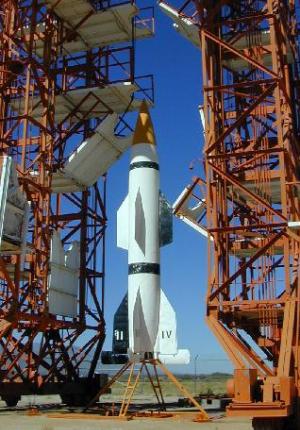 |
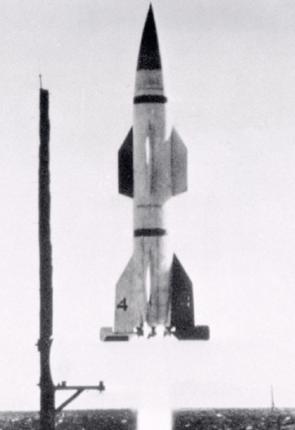 | |
| Photo: U.S. Army | Photo: NASA | |
| CTV-G-5 (RV-A-5) | ||
The CTV-G-5's aerodynamic characteristics, its propulsion system, and its radio-command guidance system were considered satisfactory. During 1950, improved versions of the CTV-G-5 were studied (as Hermes A-1E1 and Hermes A-1E2), and the designation SSM-G-15 (formally changed to SSM-A-15 in mid-1951) was reserved for a tactical surface-to-surface version of the Hermes A-1. However, the SSM-G-15 proposal was very short-lived, and in May 1950 the Hermes A-1 was again and finally reduced to a pure research program. No XSSM-G-15 missile was built as such, but it appears that one Hermes A-1E1 was assembled but not flown. The whole Hermes A-1 program was officially terminated in October 1951, when the focus for liquid-fueled rocket-powered Hermes development had shifted to the Hermes A-3.
Hermes A-2
The original Hermes A-2 was a wingless surface-to-surface derivative of the Hermes A-1, but this project died early in the planning stage around 1947. The A-2 designator was revived in 1948, when it was assigned to a proposed low-cost short-range (120 km (75 miles)) surface-to-surface missile to be powered by a solid-propellant rocket motor. Because large solid rocket motors were essentially an unexplored field at that time, the Hermes A-2 project's initial focus was on the RV-A-10 propulsion test vehicle (most probably designated RTV-G-10 before mid-1951; see note (2) on designation table below). However, a tactical missile (to be armed with a 40 kT W-7 nuclear fission warhead) was also projected as SSM-G-13 (SSM-A-13 after mid-1951).
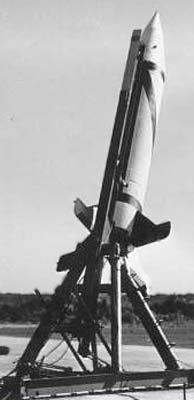 |
 | |
| Photo: U.S. Army | Image: via Ordway/Wakeford | |
| RV-A-10 | XSSM-A-13 | |
In 1950, Thiokol began the development of the United States' first large solid-fueled rocket motor. After numerous tests with subscale motors and static firings, the first flight of the RV-A-10 occurred in February 1953. It was successful and was followed by three more successful tests in March that year, which ended the program. The RV-A-10 was a completely unguided rocket, but it validated the concept of solid-fuel propulsion for large missiles. However, the tactical XSSM-A-13 Hermes A-2 had already been cancelled in October 1952, and the development of a solid-fueled short-range ballistic missile was assigned by the Army to the JPL (Jet Propulsion Laboratory), leading to the SSM-A-27/MGM-29 Sergeant.
Hermes A-3
In late 1947, the U.S. Army established preliminary characteristics for the Hermes A-3 program, calling for a liquid-fueled rocket-powered surface-to-surface missile to carry a 450 kg (1000 lb) warhead to 240 km (150 miles) with an accuracy of 60 m (200 ft) CEP. In early 1948, the designation SSM-G-8 was assigned, but the project progressed very slowly in the first years. This was mainly because of frequent changes in the requirements, which repeatedly necessitated a complete redesign of the projected XSSM-G-8 missile. However, the Hermes A-3 program accelerated somewhat in 1951, when it was split into the RV-A-8 Hermes A-3A interim test vehicle and the SSM-A-16 (briefly SSM-G-16) Hermes A-3B operational missile with a W-5 nuclear warhead (47 kT).
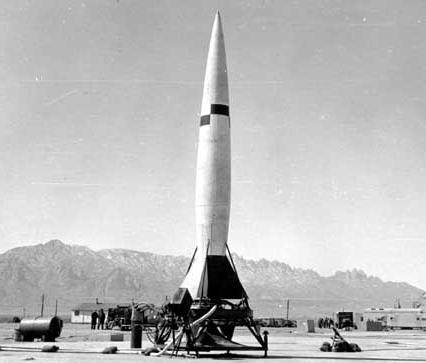 |
| Photo: U.S. Army |
| RV-A-8 |
The first flight attempt of an RV-A-8 failed in March 1953, but the second test succeeded in June that year. Until January 1954, a total of seven Hermes A-3As were launched, but only two flights were fully successful. Nevertheless, the RV-A-8's reliable (for its time) high-performace liquid-fueled rocket engine and its inertial guidance system significantly advanced the state-of-the-art in ballistic missile design. Although the Hermes A-3 program was reduced to a pure research effort in June 1953, six XSSM-A-16 Hermes A-3B missiles were launched between May and November 1954. However, only one of these (in October) was fully successful. The XSSM-A-16, originally designed as the prototype for the operational missile, was of similar design but slightly larger than the RV-A-8, and featured a further improved radio/inertial guidance system.
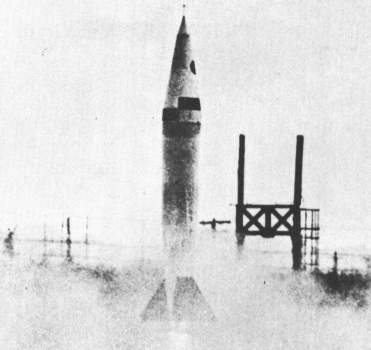 |
| Photo: via Ordway/Wakeford |
| XSSM-A-16 |
The Hermes A-3B was actually the last surviving element of the Hermes program, and the latter was finally terminated at the end of 1954. Although Hermes did not result in any operational missile, the Army's successful SSM-A-14/PGM-11 Redstone and SSM-A-27/MGM-29 Sergeant missiles owed much to the technology studied and tested during the Hermes program.
Hermes B, Hermes II
The Hermes B program was begun in 1946 with the ambitious goal to develop a ramjet-powered surface-to-surface cruise missile to carry a 450 kg (1000 lb) warhead over a range of 1600 km (1000 miles) at a speed of Mach 4. The payload and range requirements were subsequently increased to 2260 kg (5000 lb) and 2400 km (1500 miles). Because Mach 4 ramjets were way beyond the state-of-the-art in 1946, the Hermes B would require a long-term research effort. Therefore the project was split into the Hermes B-1 ramjet test vehicle and the Hermes B-2 operational missile. In 1946, the U.S. Army also established the Hermes II project, which was a broadly-defined general missile research effort to be conducted by a group of German scientists at the U.S. Army's Ordnance Research and Development Division at Ft. Bliss, TX. The first task of the Hermes II group was to design and fly a ramjet test vehicle in support of the Hermes B program. Later, in early 1948, the U.S. Army assigned the formal designations RTV-G-3, RTV-G-6 and SSM-G-9 to the Hermes II, Hermes B-1 and Hermes B-2 missiles, respectively.
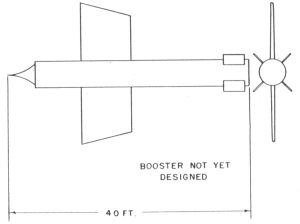 |
| Drawing: U.S. Army |
| XSSM-G-9 (very early design) |
The Hermes II test vehicle was actually the first flight-test article of the whole Hermes program. The missile consisted of a V-2, which had a ramjet-powered second stage (called "Ram") mounted semi-recessed on top. The "Ram" was a small vehicle with large wedge-shaped wings, which actually housed small rectangular-section ramjet units. This peculiar device was also called the "Organ". The V-2 first stage had enlarged fins to improve stability of the whole Hermes II missile. The Hermes II was launched into an arched trajectory, and after burnout of the V-2 engine, the "Ram" was to be separated from the V-2 by diffential aerodynamic drag. As soon as the "Ram" was no longer climbing, the ramjet units were to ignite and propel the vehicle to a speed of about 1000 m/s (3200 ft/s). The "Ram" was to carry a newly developed advanced gyro-inertial stabilization and guidance system. The first flight of a Hermes II occurred in May 1947, and used only a mockup "Ram" with dummy (non-burning) ramjets to measure dynamic pressures in the ramjet ducts. Although the flight was unsuccessful (the missile veered off course, crashing in Mexico(!)), some preliminary data was obtained.
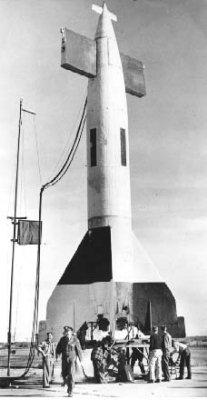 |
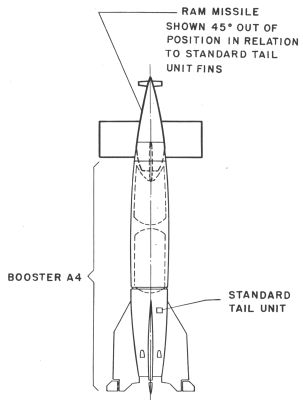 | |
| Photo/Drawing: U.S. Army | ||
| RTV-G-3 (RV-A-3) * | ||
*Note: Drawing shows original V-2 fins (RTV-G-3 as flown had larger ones)
Although further Hermes II flights were originally planned for 1947, these were postponed. The three remaining RTV-G-3 flights eventually occurred in January 1949, October 1949 and November 1950, but it is unclear whether the three latter flights carried a "Ram" with live ramjets and/or released the "Ram" into free flight. However, this seems relatively unlikely given the apparently reduced priority of Hermes II and the fact that the original schedule had planned free-flying inertially-guided live "Rams" only for flight #6 and later. The RTV-G-3 Hermes II was redesignated RV-A-3 in mid-1951.
.jpg) |
| Image: Joel Carpenter |
| "Ram" |
Whether there were any RTV-G-6 Hermes B-1 vehicles (redesignated RV-A-6 in mid-1951) is a matter of debate. There are many sources which refer to the Hermes II missile described and illustrated in the preceding paragraphs as "RTV-G-6", "RTV-A-6" (which is incorrect in any case; see note (4) on designation table below) and/or "Hermes B-1". This is actually not surprising, because the RTV-G-6/RV-A-6 was planned to be the ramjet test vehicle of the Hermes B program, and the RTV-G-3/RV-A-3 Hermes II effectively was exactly that! Furthermore, by 1951 the U.S. Army apparently used the same project number for the RV-A-3 and RV-A-6, and there is also a common project summary report for RV-A-3/RV-A-6. There are several possibilities (the first one is in my opinion by far the most likely, and the last two are almost certainly incorrect):
- The RV-A-6 was to be a completely new ramjet-powered missile, possibly closer to the projected Hermes B-2 tactical missile. If so, no RV-A-6 was ever built.
- The RV-A-6 designation was transferred to the Hermes II, when it became clear that the latter would remain the only ramjet test vehicle for the Hermes B program. If so, the RV-A-3 and RV-A-6 are actually identical.
- The RV-A-6 designation was applied to the "Ram" upper stage of the RV-A-3.
- There were three launches of V-2s with (non-burning) cylindrical ramjet ducts on top to test Hermes B propulsion technology. The RV-A-6 designator might have been applied to these tests.
The history of the projected tactical SSM-G-9 Hermes B-2, redesignated SSM-A-9 in mid-1951, is a bit unclear. Source [1] says it was cancelled in June 1950, and this is confirmed by a U.S. Army document from 1951, which lists the SSM-A-9 program as "completed". On the other hand, source [3] (an official U.S. Army history document) quotes a termination date of 1954 for the Hermes B program. However, all relevant sources agree that work on an operational ramjet-powered missile was continued after the completion of the RTV-G-3 flight tests until September 1953 under the Hermes II/RV-A-3 program. The final specifications called for a rather impressive cruise missile, flying over a range of 2400 km (1500 miles) with a speed of Mach 4.5 at 24000 m (80000 ft). These studies apparently included static firings of ramjets (quite possibly related to a projected RV-A-6 vehicle), but no all-up missile flight tests. Whatever the details are, no actual XSSM-G-9 (XSSM-A-9) Hermes B-2 missiles were ever built.
Hermes C
The Hermes C program was begun in July 1946, and covered general studies about long-range surface-to-surface guided missiles. The studies initially concentrated on boost-glide concepts, and by September 1947 a three-stage configuration had been designed. This was a 110000 kg (250000 lb) design using two liquid-propellant rocket stages and an unpowered supersonic glider stage. The first stage was to have six engines with a total thrust of 2670 kN (600000 lb) for 60s, and the second stage was a single engine providing 444 kN (100000 lb) for another 60 seconds. The glider would then deliver a 450 kg (1000 lb) warhead over a range of about 3200 km (2000 miles). However, no hardware for this design was built, because then current state-of-the-art was inadequate for this project. The Hermes C then proceeded as a low-priority study of the Hermes C-1 ballistic missile with 800 km (500 miles) range. In late 1950, the Hermes C-1 was transferred from General Electric to the Army's Guided Missile Center, where it would soon evolve into the successful SSM-A-14/PGM-11 Redstone missile.
Designation Summary
The following table summarizes the various designations of the Hermes family of vehicles. Numbers up to SSM-G-9 in the first column were assigned in early 1948, while higher numbers were allocated at some later time, but before mid-1951. Some of the designations in the post-1951 column are "paper designations" only, because the respective projects had been terminated by then.
| Name | Designations | |
|---|---|---|
| ca. February 1948 to mid-1951 | mid-1951 and later | |
| Hermes A-1 (test vehicle) | CTV-G-5 | RV-A-5 |
| Hermes A-1 (tactical missile) | SSM-G-15 (1) | SSM-A-15 |
| Hermes A-2 (test vehicle) | RTV-G-10 (1),(2) | RV-A-10 (4) |
| Hermes A-2 (tactical missile) | SSM-G-13 (1) | SSM-A-13 |
| Hermes A-3 | SSM-G-8 | (n/a) |
| Hermes A-3A (test vehicle) | RTV-G-8 (3) | RV-A-8 (4) |
| Hermes A-3B (tactical missile) | SSM-G-16 (1) | SSM-A-16 |
| Hermes B-1 (test vehicle) | RTV-G-6 | RV-A-6 (4) |
| Hermes B-2 (tactical missile) | SSM-G-9 | SSM-A-9 |
| Hermes II (test vehicle) | RTV-G-3 | RV-A-3 |
Notes:
(1) These "-G-" designations are unconfirmed, but were almost certainly assigned, because the higher numbered SSM-A-17 Corporal
was definitely the SSM-G-17 before mid-1951.
(2) Because the RV-A-10 was basically a propulsion test vehicle, a pre-1951 designation of PTV-G-10 is also possible.
(3) It's possible that the status change from tactical missile to test vehicle happened at the same time as the change to
"-A-" designations. In that case, there would have been no interim RTV-G-8 designation.
(4) These RV-A-n designations are frequently quoted as RTV-A-n. This is erroneous, because when replacing the "-G-"
nomenclature with "-A-", the Army did also drop the RTV/CTV/etc. destinction and designated all test vehicles as "RV".
Specifications
Note: Data given by several sources show slight variations. Figures given below may therefore be inaccurate!
Data for RTV-G-3 (RV-A-3), CTV-G-5 (RV-A-5), RV-A-10, RV-A-8, XSSM-A-16:
| RTV-G-3 (RV-A-3) | CTV-G-5 (RV-A-5) | RV-A-10 | RV-A-8 | XSSM-A-16 | |
|---|---|---|---|---|---|
| Length | V-2: 10.26 m (33 ft 8 in) Ram: 5.44 m (17 ft 10 in) | 7.77 m (25 ft 6 in) | 6.17 m (20 ft 3 in) | 8.74 m (28 ft 8 in) | 10.16 m (33 ft 4 in) |
| Finspan | V-2: 5.41 m (17 ft 9 in) Ram: 4.65 m (15 ft 3 in) | 2.49 m (8 ft 2 in) | 2.41 m (7 ft 11 in) | 2.29 m (7 ft 6 in) | 2.54 m (8 ft 4 in) |
| Diameter | V-2: 1.65 m (5 ft 5 in) Ram: 1.29 m (4 ft 3 in) | 86 cm (34 in) | 79 cm (31 in) | 1.02 m (3 ft 4 in) | 1.19 m (3 ft 11 in) |
| Weight | V-2: 11200 kg (24800 lb) Ram: 3200 kg (7050 lb) | 3025 kg (6675 lb) | 3530 kg (7790 lb) | 3780 kg (8340 lb) | 5370 kg (11850 lb) |
| Speed | V-2: 5800 km/h (3600 mph) Ram: 1000 m/s (3200 ft/s) | 2900 km/h (1800 mph) | 4000 km/h (2500 mph) | Mach 3.1 | |
| Ceiling | V-2: 18300 m (60000 ft) Ram: 20000 m (66000 ft) | 25 km (15 miles) | 58 km (36 miles) | 37 km (23 miles) | |
| Range | > 385 km (240 miles) | > 65 km (40 miles) | 109 km (68 miles) | 105 km (65 miles) | |
| Propulsion | V-2: Liquid-fueled rocket; 267 kN (60000 lb) Ram: G.E. ramjets |
G.E. liquid-fueled rocket; 71 kN (16000 lb) |
Thiokol solid-fueled rocket; 142 kN (32000 lb) |
G.E. liquid-fueled rocket; 80 kN (18000 lb) |
G.E. liquid-fueled rocket; 100 kN (22600 lb) |
| Warhead | none | W-5 nuclear (47 kT) | |||
Main Sources
[1] Frederick I. Ordway III, Ronald C. Wakeford: "International Missile and Spacecraft Guide", McGraw-Hill, 1960
[2] "Army Ordnance Department Guided Missiles Program", U.S. Army Ordnance Department, 1948
[3] John W. Bullard: "History of the Redstone
Missile System", U.S. Army Missile Command, 1965
[4] Joel Carpenter: "Bliss Zero and the Radical Cruise Missile Experiments of Project Hermes II" Website
(originally at http://www.ufx.org/gfb/hermes.html, now dead link)
Back to Directory of U.S. Military Rockets and Missiles, Appendix 1
Last Updated: 1 February 2003